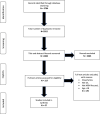Stigma, HIV Risk, and Access to HIV Prevention and Treatment Services Among Men Who have Sex with Men (MSM) in the United States: A Scoping Review
- PMID: 33866444
- PMCID: PMC8053369
- DOI: 10.1007/s10461-021-03262-4
Stigma, HIV Risk, and Access to HIV Prevention and Treatment Services Among Men Who have Sex with Men (MSM) in the United States: A Scoping Review
Abstract
In light of recent advances in HIV prevention and treatment, we reviewed the literature to understand how different types of stigma impact HIV risk; access to HIV prevention, care, and treatment services; and related health outcomes among men who have sex with men (MSM) in the US. We conducted a scoping literature review of observational and qualitative studies that examined stigma and HIV-related outcomes among MSM. Our search identified 5794 studies, of which 47 met the eligibility criteria and were included in the final analysis. The review suggests that stigma remains a formidable barrier to engaging in HIV prevention and treatment among both HIV-negative and HIV-positive MSM. Among the studies of HIV-positive MSM, internalized stigma was related to lower levels of treatment engagement. HIV-positive MSM in the Southern part of the US were also more likely to engage in risky sexual behavior. Perceived health care discrimination was negatively associated with PrEP awareness, particularly among HIV-negative Black MSM. Among young MSM of color, intersectional stigma compounded the social structural barriers to PrEP adherence. Findings indicate that stigma reduction interventions should be implemented in diverse MSM communities to address the disproportionate burden of HIV along with critical gap in the care continuum. Further research should examine how individual types of stigma, including intersectional stigma, affect viral suppression and PrEP uptake and adherence, especially among MSM of color.
Keywords: Discrimination; HIV; Intersectionality; MSM; Scoping review; Stigma.
© 2021. The Author(s), under exclusive licence to Springer Science+Business Media, LLC, part of Springer Nature.
Conflict of interest statement
The authors declare that they have no conflict of interest.
References
-
- Crocker J, Major B. Social stigma and self-esteem: the self-protective properties of stigma. Psychol Rev. 1989;96(4):608–630. doi: 10.1037/0033-295X.96.4.608. - DOI
-
- Crocker J, Major B. The self-protective properties of stigma: evolution of a modern classic. Psychol Inq. 2003;14(3/4):232–237. doi: 10.1207/S15327965PLI1403&4_9. - DOI
Publication types
MeSH terms
LinkOut - more resources
Full Text Sources
Other Literature Sources
Medical
Miscellaneous


